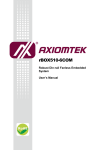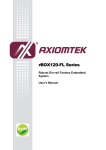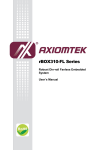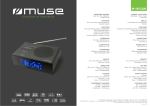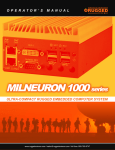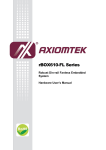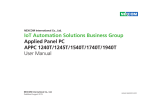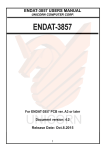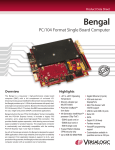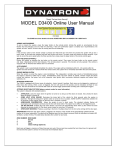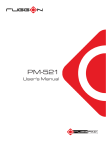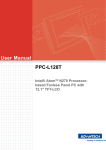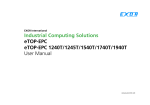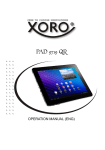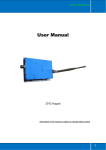Download ICO300 User`s Manual VA1
Transcript
ICO300 Series Robust Din-rail Fanless Embedded System User’s Manual Disclaimers This manual has been carefully checked and believed to contain accurate information. Axiomtek Co., Ltd. assumes no responsibility for any infringements of patents or any third party’s rights, and any liability arising from such use. Axiomtek does not warrant or assume any legal liability or responsibility for the accuracy, completeness or usefulness of any information in this document. Axiomtek does not make any commitment to update the information in this manual. Axiomtek reserves the right to change or revise this document and/or product at any time without notice. No part of this document may be reproduced, stored in a retrieval system, or transmitted, in any form or by any means, electronic, mechanical, photocopying, recording, or otherwise, without the prior written permission of Axiomtek Co., Ltd. Copyright 2015 Axiomtek Co., Ltd. All Rights Reserved June 2015, Version A4 Printed in Taiwan ii Safety Precautions Before getting started, please read the following important safety precautions. 1. The ICO300 does not come equipped with an operating system. An operating system must be loaded first before installing any software into the computer. 2. Be sure to ground yourself to prevent static charge when installing the internal components. Use a grounding wrist strap and place all electronic components in any static-shielded devices. Most electronic components are sensitive to static electrical charge. 3. Disconnect the power cord from the ICO300 before making any installation. Be sure both the system and the external devices are turned OFF. Sudden surge of power could ruin sensitive components. Make sure the ICO300 is properly grounded. 4. Make sure the voltage of the power source is correct before connecting the equipment to the power outlet. 5. Turn OFF the system power before cleaning. Clean the system using a cloth only. Do not spray any liquid cleaner directly onto the screen. 6. Do not leave this equipment in an uncontrolled environment where the storage temperature is below -45℃ or above 85℃. It may damage the equipment. 7. Do not open the system ’s back cover. If opening the cover for maintenance is a must, only a trained technician is allowed to do so. Integrated circuits on computer boards are sensitive to static electricity. To avoid damaging chips from electrostatic discharge, observe the following precautions: Before handling a board or integrated circuit, touch an unpainted portion of the system unit chassis for a few seconds. This will help to discharge any static electricity on your body. W hen handling boards and components, wear a wrist-grounding strap, available from most electronic component stores . iii Classification 1. Degree of production against electric shock: not classified 2. Degree of protection against the ingress of water: IP40 3. Equipment not suitable for use in the presence of a flammable anesthetic mixture with air or with oxygen or nitrous oxide. 4. Mode of operation: Continuous 5. Type of protection against electric shock: Class I equipment General Cleaning Tips You may need the following precautions before you begin to clean the computer . W hen you clean any single part or component for the com puter, please read and understand the details below fully. W hen you need to clean the device, please rub it with a piece of dry cloth. 1. Be cautious of the tiny removable components when you use a vacuum cleaner to absorb the dirt on the floor. 2. Turn the system off before you start to clean up the component or computer. 3. Never drop the components inside the computer or get circuit board damp or wet. 4. Be cautious of all kinds of cleaning solvents or chemicals when you use it for the sake of cleaning. Some individuals may be allergic to the ingredients. 5. Try not to put any food, drink or cigarette a round the computer. iv Cleaning Tools Although many companies have created products to help improve the process of cleaning your computer and peripherals users can also use household items to clean their computers and peripherals. Below is a listing of items you may need or want to use while cleaning your computer or computer peripherals. Keep in mind that some components in your computer may only be able to be cleaned using a product designed for cleaning that component, if this is the case it will be mentioned in the cleaning. Cloth: A piece of cloth is the best tool to use when rubbing up a component. Although paper towels or tissues can be used on most hardware as well, we still recommend you to rub it with a piece of cloth. W ater or rubbing alcohol: You may moisten a piece of cloth a bit with some water or rubbing alcohol and rub it on the computer. Unknown solvents may be harmful to the plastics parts. Vacuum cleaner: Absorb the dust, dirt, hair, cigarette particles, and other particles out of a com puter can be one of the best methods of cleaning a computer. Over time these items can restrict the airflow in a computer and cause circuitry to corrode. Cotton swabs: Cotton swaps moistened with rubbing alcohol or water are excellent tools for wiping hard to reach areas in your keyboard, mouse, and other locations. Foam swabs: W henever possible it is better to use lint free swabs such as foam swabs. Note: We strongly recommended that you should shut down the system before you start to clean any single components. Please follow the steps below: 1. Close all application programs 2. Close operating software 3. Turn off power 4. Remove all device 5. Pull out power cable v Scrap Computer Recycling If the computer equipments need the maintenance or are beyond repair, we strongly recommended that you should inform your Axiomtek distributor as soon as possible for the suitable solution. For the computers that are no longer useful or no longer working well, please contact your Axiomtek distributor for recycling and we will make the proper arrangement. Trademarks Acknowledgments Axiomtek is a trademark of Axiomtek Co., Ltd. IBM, PC/AT, PS/2, VGA are trademarks of International Business Machines Corporation. ® ® Intel and Pentium are registered trademarks of Intel Corporation. MS-DOS, Microsoft C and QuickBASIC are trademarks of Microsoft Corporation. VIA is a trademark of VIA Technologies, Inc. SST is a trademark of Silicon Storage Technology, Inc. UMC is a trademark of United Microelectronics Corporation.Other brand names and trademarks are the properties and registered brands of their respective owners . vi Table of Contents Safety Precautions ................................................................................................. iii Classification .......................................................................................................... iv General Cleaning Tips ........................................................................................... iv Scrap Computer Recycling ................................................................................... vi CHAPTER 1 INTRODUCTION ................................................................................. 1 1.1 1.2 1.2.1 1.2.2 1.2.3 1.2.4 1.2.5 1.2.6 1.2.7 1.2.8 1.2.9 1.2.10 1.2.11 1.2.12 1.2.13 1.2.14 1.2.15 1.2.16 1.2.17 1.2.18 1.2.19 1.2.20 1.3 1.4 General Description ............................................................................ 1 System Specifications ........................................................................ 2 CPU .................................................................................................................... 2 BIOS ................................................................................................................... 2 System Memory ................................................................................................ 2 Display ............................................................................................................... 2 Ethernet Ports ................................................................................................... 2 Storages ............................................................................................................. 2 Wireless ............................................................................................................. 2 USB .................................................................................................................... 3 COM .................................................................................................................... 3 Power ................................................................................................................. 3 DIO (ICO300-DIO) .............................................................................................. 4 WatchDog Timer (WDT).................................................................................... 4 Restore BIOS Optimal Defaults (JP2) ............................................................. 4 System LED ....................................................................................................... 4 Operation Temperature .................................................................................... 5 Storage Temperature ........................................................................................ 5 Humidity............................................................................................................. 5 Weight ................................................................................................................ 5 Dimensions........................................................................................................ 5 System I/O Outlets ............................................................................................ 5 Dimensions ......................................................................................... 6 I/O Outlets ........................................................................................... 7 CHAPTER 2 HARDWARE INSTALLATION .......................................................... 9 2.1 2.2 2.3 2.4 2.5 Installing the Memory Module ............................................................ 9 Installing the CompactFlash (CF) .................................................... 11 Installing the Hard Disk Drive .......................................................... 12 Installing Din-rail Mounting .............................................................. 14 Installing Wall Mounting (optional).................................................. 16 CHAPTER 3 AMI UEFI BIOS UTILITY ................................................................. 17 3.1 3.2 3.3 3.4 3.5 3.6 3.7 Entering Setup .................................................................................. 17 The Main Menu .................................................................................. 18 Advanced Features ........................................................................... 19 Chipset Feature ................................................................................. 35 Security.............................................................................................. 37 Boot Type .......................................................................................... 39 Save & Exit ........................................................................................ 43 vii APPENDIX A WATCHDOG TIMER ....................................................................... 47 About Watchdog Timer .................................................................................... 47 How to Use Watchdog Timer ........................................................................... 47 viii ICO300 Series User’s Manual CHAPTER 1 INTRODUCTION This chapter contains general information and detailed specifications of the ICO300. The Chapter 1 includes the following sections: General Description System Specification Dimensions I/O Outlets 1.1 General Description ICO300 Din-rail fanless embedded system is suitable for communications control and for protocol converter applications in critical environments. Built fo r rugged work ® environments, ICO300 features an extra low power consumption Intel ATOM ™ E3815 (1.46GHz) or E3827 (1.75GHz) processors supporting industrial temperature range of -20℃ to +70℃. Its front accessible I/O cabling is very convenient for wiring and maintenance. ICO300 offers a VGA output, making it particularly well-suited for communication control, SCADA and industrial automation. Its compact size with D inrail mounting allows for easy installation into control cabinet. Pre -installed with Linux, ® W indows 7 embedded and W indows 8 embedded, ICO300 provides programmers with a friendly environment for developing applic ation software at a lower cost. ICO300 is robust industrial-grade hardware design and adopts the advanced cooling system, besides, supporting the CompactFlash™ and SATA SSD (or HDD), which makes it especially suitable for field control & monitoring system solution for following markets: Utility Industries (Water; Energy; Chemical Plant; Mining…) Public Transportation Industries (Traffic/ Highway Control; Train/Bus Control…) Homeland Security (Weather Monitoring/Alarm System…) Features Fanless design Wide temperature operation of -20℃ - +70℃ (-40℃ - +70℃ for optional ) Supports 2 10/100/1000 Base-T Ethernets with Magnetic Isolated Protection 4 COM Ports support RS-232/422/485 Wireless (3G/GPRS or Wifi) Support one 2.5” SATA SSD (or HDD) and one CompactFlash™ (or mSATA ) Wide range 12–24V DC-in with terminal block 8 bits programmable TTL level digital input/output ports (ICO300-DIO). Din-rail mounting Wall mounting (optional) Passed CE with FCC testing Introduction 1 ICO300 Series User’s Manual Embedded O.S. Supported ® ® ICO300 not only supports W indows 7 and W indows 8, but also supports ® ® embedded OS, such as W indows 7 embedded, W indows 8 embedded and Linux package support. For storage device, ICO300 supports one SATA SSD (or HDD) and one type II CompactFlash ™ socket. 1.2 System Specifications 1.2.1 ® Onboard Intel ATOM™ E3815 (1.46 GHz) processor or E3827 (1.75GHz) processor 1.2.2 CPU BIOS AMI (American Megatrends Inc.) UEFI (Unified Extensible Firmware Interface) BIOS. 1.2.3 System Memory One DDR3L 204-pin SO-DIMM (1.35V) slot. Supports 1066MHz up to 4GB (E3815), up to 8GB (E3827). 1.2.4 A slim type 15-pin D-Sub connector as VGA connector. 1.2.5 Display Ethernet Ports LAN 1 and LAN 2 The board has dual RJ-45 connectors, support 10/100/1000 Base-T with 1.5KV magnetic isolated protection. 1.2.6 Storages 1 x 2.5” SATA SSD (or HDD) drive bay. 1 x CompactFlash TypeII socket (or mSATA). 1.2.7 Wireless 1 x Full size Mini Card slot supports 3G/GPRS or Wifi. 1 x SIM Card Socket. 2 x Antenna holes. Note: CF and mSATA function can be either one, it can be selected by BIOS menu. mSATA and wireless use the same slot, and only one of them can be selected. 2 Introduction ICO300 Series User’s Manual 1.2.8 USB 2 x USB2.0 USB Pin Define : Pin Signal USB Port 0 Pin Signal USB Port 1 1 2 3 4 VCC DD+ GND 5 6 7 8 VCC DD+ GND 1.2.9 5 6 7 8 1 2 3 4 COM 4 ports DB9 support RS-232/422/485 which can be selected by BIOS. Supports Auto Flow Control in RS485 mode. Serial Port Pin Define: (DB9 Male) as below COM1~4 Pin RS-232 RS-422 RS-485 1 DCD TX- Data- 2 RXD TX+ Data+ 3 TXD RX+ -- 4 DTR RX- -- 5 GND GND GND 6 DSR -- -- 7 RTS -- -- 8 CTS -- -- 9 RI -- -- 1.2.10 Power Wide-range 12 - 24V DC power input with terminal block. OVP and Reverse protection. Pin Signal 1 + 2 NC 3 - Introduction 3 ICO300 Series User’s Manual 1.2.11 One DB9 female connector supports 8 bits TTL level programmable digital input/output Pin Signal 1 DIO0 2 DIO1 3 DIO2 4 DIO3 5 DIO4 6 DIO5 7 DIO6 8 DIO7 9 GND 1.2.12 Restore BIOS Optimal Defaults (JP2) Put jumper clip to pin 2-3 for a few seconds then move it back to pin 1 -2. Doing this procedure can restore BIOS optimal defaults . Function Setting Normal (Default) 1-2 close Restore BIOS optimal defaults 2-3 close 1.2.14 WatchDog Timer (WDT) 1~255 seconds or minutes; up to 255 levels . 1.2.13 DIO (ICO300-DIO) System LED There are showed the LED’s indicators and functional descriptions. LED Name 4 Description Color ACT Indicate the storge status and it’s flashing when storge access. Green PWR Indicate the Power status. When the DC input is acceptable, the LED will ON. Yellow Introduction ICO300 Series User’s Manual 1.2.15 Operation Temperature -20℃ ~ +70℃ -40℃ ~ +70℃ (optional) 1.2.16 -40℃ ~ +85℃ 1.2.17 Weight 1 kg 1.2.19 Humidity 10% ~ 95% (non-condensation) 1.2.18 Storage Temperature Dimensions 48mm(1.88”) (W) x110mm(4.33”) (D) x155mm(6.1”) (H) 1.2.20 System I/O Outlets Four 9-pin D-Sub male connectors, COM1~COM4. One 15-pin D-Sub female connector for VGA. Two 10/100/1000 Base-T RJ-45 with 1.5KV magnetic isolated protection. Two USB 2.0 connectors. One DC Power Input with terminal block. One 9-pin D-Sub Female connectors for DIO. (ICO300-DIO) Two Antenna holes. Introduction 5 ICO300 Series User’s Manual 1.3 Dimensions The following diagrams show you dimensions and outlines of theICO300/ICO300-DIO. 6 Introduction ICO300 Series User’s Manual 1.4 I/O Outlets The following figures show you I/O outlets on front view and top view of the ICO300/ICO300-DIO. Introduction 7 ICO300 Series User’s Manual 8 Introduction ICO300 Series User’s Manual CHAPTER 2 HARDWARE INSTALLATION The ICO300 is convenient for your various hardware configurations, such as Memory Module and Hard Disk Drive. The chapter 2 will show you how to install the hardware. It includes: 2.1 Installing the Memory Module Step 1 Turn off the system. Step 2 Loosen all screws of the cover and remove the cover from the system. Step 3 Use two fingers to hold the memory module, and insert the gold figure into the slot and push the module down. Hardware Installation 9 ICO300 Series User’s Manual Step 4 The memory module is locked by two latches on the sides. We strongly recommend using “LDC737” silicone on the two sides of the memory for good ability of vibration. Step 5 Put the cover back to the system, and fasten screws tight close the chassis. 10 Hardware Installation ICO300 Series User’s Manual 2.2 Installing the CompactFlash (CF) Step 1 Turn off the system. Step 2 Loosen all screws of the cover and remove the cover from the system. Step 3 Stick CF mylar on CF card. Step 4 Insert the CF card into the socket tightly. Note: Pull out the CF card from the socket when taking out. Hardware Installation 11 ICO300 Series User’s Manual 2.3 Step 1 Installing the Hard Disk Drive Turn off the system. Step 2 Loosen all screws of the cover and remove the cover from the system. Step 3 12 Loosen 4pcs screws of the cover, and put the HDD into the HDD bracket and fix the HDD by 4pcs of screws in the accessory bag. Hardware Installation ICO300 Series User’s Manual Step 4 Put the HDD bracket on the cover and use 4pcs screws to fix tightly. Takes the SATA+Power HDD cable and Cable Tie out from the accessory bag and connect SATA+Power HDD cable to HDD then use Cable Tie to fix it on the HDD bracket, cut off the lengthy Cable Tie. Step 5 Connect SATA+Power HDD cable to the board connector, SATA side first then power side second. Step 6 Put the cover back to the system, and fasten screws tight close the chassis. Hardware Installation 13 ICO300 Series User’s Manual 2.4 Installing Din-rail Mounting The ICO300 provides Din-rail Mount for 2 methods that customers can install as below: Step 1 Prepare Din-rail Mount assembling components (screws and bracket) ready. Step 2 Assembly the bracket to the system and fasten screws tight. Method -1: 14 Hardware Installation ICO300 Series User’s Manual Method-2 : Hardware Installation 15 ICO300 Series User’s Manual 2.5 Installing Wall Mounting (optional) The ICO300 provides W all Mounting that customers can install as below: Step 1 Prepare Wall Mount assembling components (screws and bracket) ready. Step 2 Assembly the bracket to the system, and fasten screws tight. 16 Hardware Installation ICO300 Series User’s Manual CHAPTER 3 AMI UEFI BIOS UTILITY The AMI UEFI BIOS provides users with a built-in Setup program to modify basic system configuration. All configured parameters are stored i n a flash-backed-up to save the Setup information whenever the power is turned off . 3.1 Entering Setup To enter the setup screens, follow the steps below: 1. Turn on the computer and press the <Del> key immediately. 2. After you press the <Del> key, the main BIOS setup menu displays. You can access the other setup screens from the main BIOS setup menu, such as the Advanced and Chipset menus. AMI UEFI BIOS Utility 17 ICO300 Series User’s Manual 3.2 The Main Menu Once you enter the AMI BIOS Aptio Setup Utility, the Main Menu appears on the screen. In the Main Menu, there are several Setup functions and a couple of Exit options for your selection. Use Select Screen Keys (or Move Keys) to select the Setup Page you intend to configure then press <Enter> to accept or e nter its submenu. System Date The date format is <day> <month> <date> <year>. System Time This item shows current time of your system with the format <hour> <minute> <second>. The time is calculated based on the 24-hour military-time clock. For example, 1 p.m. is 13:00:00. 18 AMI UEFI BIOS Utility ICO300 Series User’s Manual 3.3 Advanced Features This Advanced section allows users to configure and improve your system, to set up some system features according to your preference. You can select any of the items in the left frame of the screen to go to the sub menus: AMI UEFI BIOS Utility 19 ICO300 Series User’s Manual Serial Port Configuration The default setting for all Serial Ports are RS232. You can change the setting by selecting the value you want in each COM Port Type. Supports internal 120 ohms terminator in RS422 & RS485 mode. (Please refer below graphics.) 20 AMI UEFI BIOS Utility ICO300 Series User’s Manual AMI UEFI BIOS Utility 21 ICO300 Series User’s Manual 22 AMI UEFI BIOS Utility ICO300 Series User’s Manual H/W Monitor Scroll to this item and press <Enter> to view the monitor hardware status. (Please refer below graphics.) AMI UEFI BIOS Utility 23 ICO300 Series User’s Manual RTC Wake Settings The default setting is “disable”. If the setting is changed for “enable”, you can set up the fixed time to boot up automatically. (Please refer below graphics.) 24 AMI UEFI BIOS Utility ICO300 Series User’s Manual AMI UEFI BIOS Utility 25 ICO300 Series User’s Manual 26 AMI UEFI BIOS Utility ICO300 Series User’s Manual AMI UEFI BIOS Utility 27 ICO300 Series User’s Manual Serial Port Console Redirection Only COM1 has the console redirection function. The default setting for the console redirection fu nction is [Disabled] (Please refer below graphics.) 28 AMI UEFI BIOS Utility ICO300 Series User’s Manual If the setting for the console redirection function is changed for [Enabled], the settings specify how the host computer and the remote computer (which the user is using) will exchange data. Both computers should have the same or compatible settings. AMI UEFI BIOS Utility 29 ICO300 Series User’s Manual And you can further change the setting by selecting or setting the value you want in each function as the following pictures. 30 AMI UEFI BIOS Utility ICO300 Series User’s Manual CPU Configuration Scroll to this item and press <Enter> to view the CPU Configuration informations. (Please refer below graphics.) AMI UEFI BIOS Utility 31 ICO300 Series User’s Manual IDE Configuration Scroll to this item and press <Enter> to view the IDE Configuration informations. (Please refer below graphics.) 32 AMI UEFI BIOS Utility ICO300 Series User’s Manual Note: CF and mSATA function can be either one, it can be select by BIOS menu. mSATA and wireless use the same slot, and only one of them can be selected. AMI UEFI BIOS Utility 33 ICO300 Series User’s Manual USB Configuration Scroll to this item and press <Enter> to view the USB Configuration informations . (Please refer below graphics.) 34 AMI UEFI BIOS Utility ICO300 Series User’s Manual 3.4 Chipset Feature This section contains completely optimized chipset ’s features in the system AMI UEFI BIOS Utility 35 ICO300 Series User’s Manual 36 AMI UEFI BIOS Utility ICO300 Series User’s Manual 3.5 Security The default setting for Administrator Password is “Not setting passwords”. The Security menu allows users to change the security settings for the system. You can set the password for both Administrator Password and User Password. (Please refer below graphics.) AMI UEFI BIOS Utility 37 ICO300 Series User’s Manual Note: The BIOS default has no password, when user created the password, please remember the password number, if users forget password the RMA is the only solution. 38 AMI UEFI BIOS Utility ICO300 Series User’s Manual 3.6 Boot Type The default setting boot from onboard LAN PxE Rom is [Disabled] (Please refer below graphics.) AMI UEFI BIOS Utility 39 ICO300 Series User’s Manual The Boot Option Priorities can select by Boot Option #1, #2… (Please refer below graphics.) 40 AMI UEFI BIOS Utility ICO300 Series User’s Manual Hard Drive BBS Priorites supports the hard drive boot option. AMI UEFI BIOS Utility 41 ICO300 Series User’s Manual 42 AMI UEFI BIOS Utility ICO300 Series User’s Manual 3.7 Save & Exit This section allows you to determine whether or not to accept your modifications. Type “Y” to quit the setup utility and save all change s. Type “N” to bring you back to the Previous Setup utility. (Please refer below graphics.) AMI UEFI BIOS Utility 43 ICO300 Series User’s Manual 44 AMI UEFI BIOS Utility ICO300 Series User’s Manual AMI UEFI BIOS Utility 45 ICO300 Series User’s Manual This page is intentionally left blank. 46 AMI UEFI BIOS Utility ICO300 Series User’s Manual APPENDIX A WATCHDOG TIMER About Watchdog Timer After the system stops working for a while, it can be auto-reset by the watchdog timer. The integrated watchdog timer can be set up in the system reset mode by program. How to Use Watchdog Timer The following example enables configuration using debug tool. Enable WDT Enable configuration: O 2E 87 ; Un-lock super I/O O 2E 87 Select logic device: O 2E 07 O 2F 08 WDT device enable: O 2E 30 O 2F 01 Set timer unit: O 2E F0 O 2F 00 ; (00: Sec; 08:Minute) Set base timer: O 2E F1 O 2F 0A ; Set reset time (where 0A (hex) = 10sec) Watchdog Timer 47 ICO300 Series User’s Manual Disable WDT Enable configuration: O 2E 87 ; Un-lock super I/O O 2E 87 Select logic device: O 2E 07 O 2F 08 WDT device disable: O 2E 30 O 2F 00 48 Watchdog Timer
























































